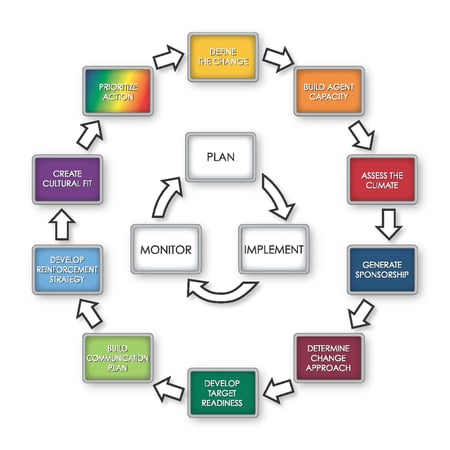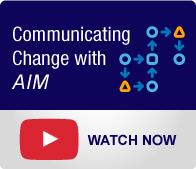Tell me if this sounds familiar. Your organization is getting ready for a major change. The “go-live” date is drawing near, and someone says, “Oh wait! We need to do change management!” Someone else says, “Don’t worry, we’ve got that covered. A mass email is going out next week, the website will go live right after that and there will be several social media posts as well.” Excellent. They definitely have that covered. I’m sure this change will be very successful (insert eye roll here). 
Why is it that so many people still believe if they tell people about a change, and tell them more often it will be enough to get buy-in and then magically people will change their behavior? If it were that easy, nobody would smoke, and we would all be at our ideal weight!
Is having a communication plan during a business change important? Of course, absolutely! But communication alone is not going to be enough to change people’s behavior.
The 5 Metrics for Success
There are 5 metrics that must be met on every project in order to deem it successful:
- It’s delivered on time
- It’s delivered on budget
- The technical objectives are achieved
- The business objectives are achieved
- AND it meets the human objectives that have been established for the change
Contrary to popular belief, the greatest risk for failure or sub-optimization is actually on the human side of the equation, not the technical side. A few examples of sub-optimal human side issues might include:
- End users who don’t adopt the new processes or use work-arounds rather than accept the new tools/methods
- Resistance that is generated from the degree of work disruption is left unmanaged and slows down change
- Old Reinforcements are still being applied and don’t match new expectations
- Leaders at all levels don’t take an active role in the change implementation
Sending an email from mahogany row explaining the logic and rationale behind the change is not going to solve any of these issues! So, don’t be fooled. While communication is certainly an important part of change management, it is not the same as a full change management implementation plan.
Implementation Planning
When building a change implementation plan there are several key steps that must be addressed. At a minimum, a full implementation plan must include:
- A Business Case for Action: The starting point for every strategic initiative must be a clear, compelling Definition of the Change. Gaining alignment on the scope and definition of the change, including the identification of the human objectives is imperative. There are four questions that must be commonly understood by everyone involved in the change. What are we changing? Why are we changing? What are the consequences for not changing? And how will the progress be measured?
- Generating Sponsorship: Sponsorship is the single most important factor in implementation success! But Project Sponsorship is not just one executive who signs a check authorizing funding for your initiative and then shows up at the project launch meeting. It’s also not a steering committee of key leaders tasked with making strategic decisions along the way. Project Sponsorship is the “cascade” of managers, level by management level, throughout the organization, in every area affected by the change. Each of these leaders must be Expressing, Modeling and Reinforcing their personal and public commitment to the change with their direct reports.

- Developing Target Readiness: Resistance is a function of the level of disruption of change. It is how people protect themselves against changes in behaviors, Reinforcement, work characteristics, power and/or status. But remember, Readiness and Resistance are two sides of the same coin. If you spend some of your resource energy early in the project life cycle on building Readiness you’ll spend less time and need fewer resources dealing with Resistance later.
- Developing a Reinforcement Strategy: Reinforcement is the real power lever to motivate behavioral changes. Next Generation Change Agents need to focus on working with their Sponsors to implement appropriate reinforcements (both positive rewards and negative consequences) with the Sponsors’ direct reports. But remember, reinforcement management is more about the daily interaction between the Sponsor and their direct report and less about their formal compensation.
- Building a Communication Plan: The AIM methodology centers communication efforts on delivering the right message to the right audience using the right communication vehicles, and always includes a feedback loop to gather reactions to both the content of the change, and how the change is being implemented.
With the amount of money being spent on strategic initiatives at an all time high, it is more important than ever for an organization to extract maximum value from the projects it elects to implement. That’s why it just makes sense to plan for the human side in the same way you plan for the technical side of your projects. These plans should not be separate from each other, but instead integrated from the start. And yes, communication should be one part of the plan, but it definitely should not be the whole plan!


